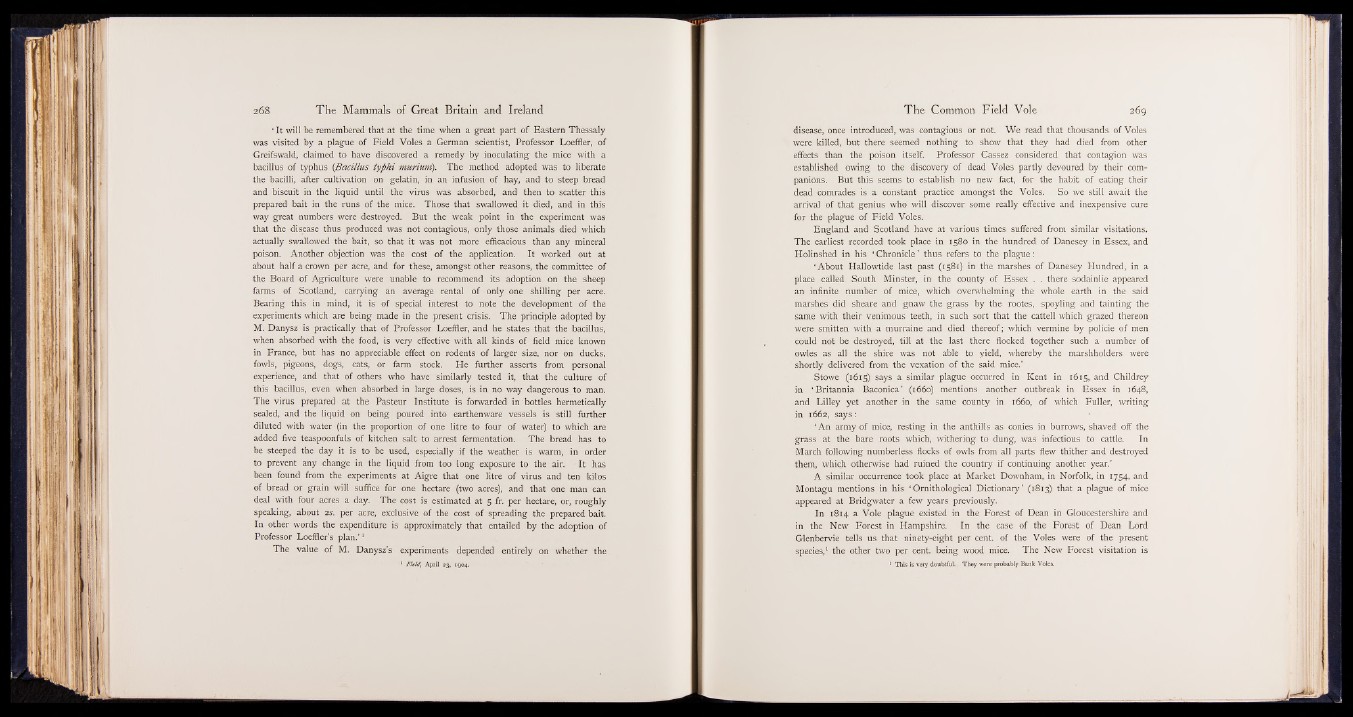
‘ It will be remembered that at the time when a great part of Eastern Thessaly
was visited by a plague of Field Voles a German scientist, Professor Loeffler, of
Greifswald, claimed to have discovered a remedy by inoculating the mice with a
bacillus of typhus (.Bacillus typhi murium). The method adopted was to liberate
the bacilli, after cultivation on gelatin, in an infusion of hay, and to steep bread
and biscuit in the liquid until the virus was absorbed, and then to scatter this
prepared bait in the runs of the mice. Those that swallowed it died, and in this
way great numbers were destroyed. But the weak point in the experiment was
that the disease thus produced was not contagious, only those animals died which
actually swallowed the bait, so that it was not more efficacious than any mineral
poison. Another objection was the cost of the application. It worked out at
about half a crown per acre, and for these, amongst other reasons, the committee of
the Board of Agriculture were unable to recommend its adoption on the sheep
farms of Scotland, carrying an average rental of only one shilling per acre.
Bearing this in mind, it is of special interest to note the development of the
experiments which are being made in the present crisis. The principle adopted by
M. Danysz is practically that of Professor Loeffler, and he states that the bacillus,
when absorbed with the food, is very effective with all kinds of field mice known
in France, but has no appreciable effect on rodents of larger size, nor on ducks,
fowlsjv v pigeons, dogs, cats, or farm stock. He further asserts from personal
experience, and that of others who have similarly tested it, that the culture of
this bacillus, even when absorbed in large doses, is in no way dangerous to man.
The virus prepared at the Pasteur Institute is forwarded in bottles hermetically
sealed, and the liquid on being poured into earthenware vessels is still further
diluted with water (in the proportion of one litre to four of water) to which are
added five teaspoonfuls of kitchen salt to arrest fermentation. The bread has to
be steeped the day it is to be used, especially if the weather is warm, in order
to prevent any change in the liquid from too long exposure to the air. It has
been found from the experiments at Aigre that one litre of virus and ten kilos
of bread or grain will suffice for one hectare (two acres), and that one man can
deal with four acres a day. The cost is estimated at 5 fr. per hectare, or, roughly
speaking, about 2s. per acre, exclusive of the cost of spreading the prepared bait.
In other words the expenditure is approximately that entailed by the adoption of
Professor Loeffler’s plan.’ 1
The value of M. Danysz’s experiments depended entirely on whether the
1 F ie ld April 23, 1904.
disease, once introduced, was contagious or not. We read that thousands of Voles
were killed, but there seemed nothing to show that they had died from other
effects than the poison itself. Professor Cassez considered that contagion was
established owing to the discovery of dead Voles partly devoured by their companions.
But this seems to establish no new fact, for the habit of eating their
dead comrades is a constant practice amongst the Voles. So we still await the
arrival of that genius who will discover some really effective and inexpensive cure
for the plague of Field Voles.
England and Scotland have at various times suffered from similar visitations.
The earliest recorded took place in 1580 in the hundred of Danesey in Essex, and
Holinshed in his ‘ Chronicle ’ thus refers to the plague:
‘ About Hallowtide last past (1581) in the marshes of Danesey Hundred, in a
place called South Minster, in the county of Essex . . there sodainlie appeared
an infinite number of mice, which overwhelming the whole earth in the said
marshes did sheare and gnaw the grass by the rootes, spoyling and tainting the
same with their venimous teeth, in such sort that the cattell which grazed thereon
were smitten with a murraine and died thereof; which vermine by policie of men
could not be destroyed, till at the last there flocked together such a number of
owles as all the shire was not able to yield, whereby the marshholders were
shortly delivered from the vexation of the said mice.’
Stowe (1615) says a similar plague occurred in Kent in 1615, and Childrey
in ‘ Britannia Baconica’ (1660) mentions another outbreak in Essex in 1648,
and Lilley yet another in the same county in 1660, of which Fuller, writing
in 1662, sa y s :
‘ An army of mice, resting in the anthills as conies in burrows, shaved off the
grass at the bare roots which, withering to dung, was infectious to cattle. In
March following numberless flocks of owls from all parts flew thither and destroyed
them, which otherwise had ruined the country if continuing another year.’
A similar occurrence took place at Market Downham, in Norfolk, in 1754, and
Montagu mentions in his ‘ Ornithological Dictionary’ (1813) that a plague of mice
appeared at Bridgwater a few years previously.
In 1814 a Vole plague existed in the Forest of Dean in Gloucestershire and
in the New Forest in Hampshire. In the case of the Forest of Dean Lord
Glenbervie tells us that ninety-eight per cent, of the Voles were of the present
species,1 the other two per cent, being wood mice. The New Forest visitation is
1 This is very doubtful.. They were probably Bank Voles.